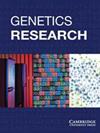The Clinical Relevance and Functional Implications of Thymosin Beta-10 in Glioma
IF 2.1
4区 生物学
Q4 GENETICS & HEREDITY
引用次数: 0
Abstract
Glioma is a highly aggressive form of brain cancer characterized by limited treatment options and poor patient prognosis. In this study, we aimed to elucidate the oncogenic role of thymosin beta-10 (TMSB10) in glioma through comprehensive analyses of patient data from the TCGA and GTEx databases. Our investigation encompassed several key aspects, including the analysis of patients’ clinical characteristics, survival analysis, in vitro and in vivo functional experiments, and the exploration of correlations between TMSB10 expression and immune cell infiltration. Our findings revealed a significant upregulation of TMSB10 expression in glioma tissues compared to normal brain tissues, with higher expression levels observed in tumors of advanced histological grades. Moreover, we observed positive correlations between TMSB10 expression and patient age, while no significant association with gender was detected. Additionally, TMSB10 exhibited marked elevation in gliomas with wild-type IDH and noncodeletion of 1p/19q. Survival analysis indicated that high TMSB10 expression was significantly associated with worse overall survival, disease-specific survival, and progression-free survival in glioma patients. Functionally, knockdown of TMSB10 in glioma cells resulted in reduced cellular growth rates and impaired tumor growth in xenograft models. Furthermore, our study revealed intriguing correlations between TMSB10 expression and immune cell infiltration within the tumor microenvironment. Specifically, TMSB10 showed negative associations with plasmacytoid dendritic cells (pDC) and γδ T cells (Tgd), while displaying positive correlations with neutrophils and macrophages. These findings collectively provide valuable insights into the oncogenic properties of TMSB10 in glioma, suggesting its potential as a therapeutic target and a biomarker for patient stratification.胸腺酶β -10在胶质瘤中的临床意义和功能意义
胶质瘤是一种高度侵袭性的脑癌,其特点是治疗选择有限,患者预后差。在这项研究中,我们旨在通过对TCGA和GTEx数据库中患者数据的综合分析,阐明胸腺酶β -10 (TMSB10)在胶质瘤中的致癌作用。我们的研究包括几个关键方面,包括患者临床特征分析,生存分析,体外和体内功能实验,以及探索TMSB10表达与免疫细胞浸润的相关性。我们的研究结果显示,与正常脑组织相比,胶质瘤组织中TMSB10的表达显著上调,在晚期组织学分级的肿瘤中观察到更高的表达水平。此外,我们观察到TMSB10表达与患者年龄呈正相关,而与性别无显著相关性。此外,TMSB10在野生型IDH和1p/19q非编码的胶质瘤中表现出明显的升高。生存分析表明,高TMSB10表达与胶质瘤患者的总生存、疾病特异性生存和无进展生存显著相关。功能上,在异种移植瘤模型中,胶质瘤细胞中TMSB10的敲低导致细胞生长速率降低和肿瘤生长受损。此外,我们的研究揭示了肿瘤微环境中TMSB10表达与免疫细胞浸润之间的有趣相关性。具体而言,TMSB10与浆细胞样树突状细胞(pDC)和γδ T细胞(Tgd)呈负相关,与中性粒细胞和巨噬细胞呈正相关。这些发现共同为TMSB10在胶质瘤中的致癌特性提供了有价值的见解,表明其作为治疗靶点和患者分层的生物标志物的潜力。
本文章由计算机程序翻译,如有差异,请以英文原文为准。
求助全文
约1分钟内获得全文
求助全文
来源期刊

Genetics research
生物-遗传学
自引率
6.70%
发文量
74
审稿时长
>12 weeks
期刊介绍:
Genetics Research is a key forum for original research on all aspects of human and animal genetics, reporting key findings on genomes, genes, mutations and molecular interactions, extending out to developmental, evolutionary, and population genetics as well as ethical, legal and social aspects. Our aim is to lead to a better understanding of genetic processes in health and disease. The journal focuses on the use of new technologies, such as next generation sequencing together with bioinformatics analysis, to produce increasingly detailed views of how genes function in tissues and how these genes perform, individually or collectively, in normal development and disease aetiology. The journal publishes original work, review articles, short papers, computational studies, and novel methods and techniques in research covering humans and well-established genetic organisms. Key subject areas include medical genetics, genomics, human evolutionary and population genetics, bioinformatics, genetics of complex traits, molecular and developmental genetics, Evo-Devo, quantitative and statistical genetics, behavioural genetics and environmental genetics. The breadth and quality of research make the journal an invaluable resource for medical geneticists, molecular biologists, bioinformaticians and researchers involved in genetic basis of diseases, evolutionary and developmental studies.
 求助内容:
求助内容: 应助结果提醒方式:
应助结果提醒方式:


